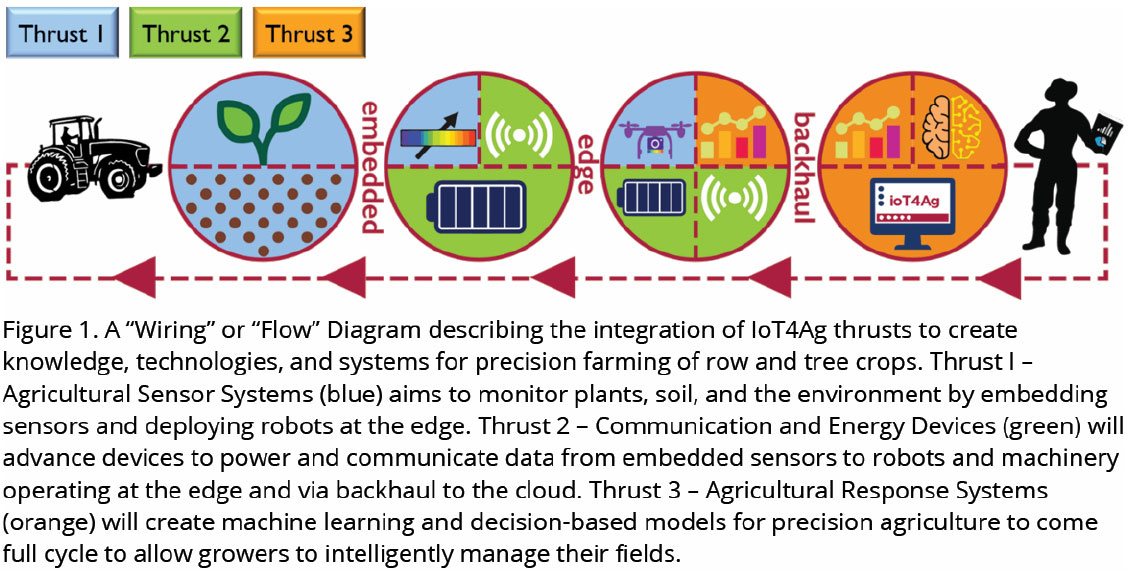Monitoring of agricultural crops is still accomplished primarily through the expensive, labor-intensive, and time-consuming process of crop scouting, by manual sampling and documenting the state of the field. Precision agriculture involves the use of technology to acquire and analyze data from the field. However currently technologies such as sensors are limited or non-existent to spatially, temporally, and compositionally monitor the state of the field, data is coarse-grained and siloed in equipment, communications infrastructure is limited or non-existent on the farm, and interventions are reactive and over-provisioned, increasing economic and environmental costs. While the concept of precision agriculture has existed for 30 years, the exponential growth in information technology and data science and the reduction in their cost is setting the stage for the next revolution in agricultural practices.
The opportunity for technological innovation to impact agricultural crop practices and production and thus to ensure a food, energy, and water secure future and the health and prosperity of humanity is highlighted in recent reports.
IoT4Ag will create novel, integrated systems that capture the microclimate and spatially, temporally, and compositionally map heterogeneous stresses for early detection and intervention to better outcomes in agricultural crop production. The Center will create internet of things (IoT) technologies to optimize practices for every plant; from sensors, robotics, and energy and communication devices to data-driven models constrained by plant physiology, soil, weather, management practices, and socio-economics.
IoT4Ag will create novel, integrated systems that capture the microclimate and spatially, temporally, and compositionally map heterogeneous stresses for early detection and intervention to better outcomes in agricultural crop production. The Center will create internet of things (IoT) technologies to optimize practices for every plant; from sensors, robotics, and energy and communication devices to data-driven models constrained by plant physiology, soil, weather, management practices, and socio-economics.

Thrust 1: Agricultural Sensor Systems will design and manufacture resilient, networked, intelligent sensor-robotic systems that monitor the state of plant and soil health over extended areas. Thrust 1 will address fundamental scientific questions to uncover how the complex system of abiotic and biotic variables affect crop yield and resilience, and with this knowledge design technologies and systems that will be deployed with the spatial, temporal, and compositional resolution needed to capture the state of the field.
Thrust 2: Communication and Energy Systems will enable advanced approaches for powering IoT devices and robots in the field and for data communication from heterogeneous platforms of sensors, robots, and farming equipment. Thrust 2 will establish the knowledge and technologies specifically needed in agriculture, from powering devices and communicating from below the soil surface to deploying technologies at field scales.
Thrust 3: Agricultural Response Systems will create and deploy smart response systems that are driven by machine learning and decision-based models for precision agriculture. Thrust 3 will create techniques to manage uncertainty and fuse the spatially, temporally, and compositionally heterogeneous data from the field to collect not just more, but better data. The Thrust will build models, constrained by the biophysics of plants in agricultural fields, to establish a decision-Ag interface for growers to intelligently manage their fields in a cost-effective manner.
IoT4Ag technologies will be evaluated in two Testbeds:
1) University of Florida’s Research & Education Center – Integrated Systems for Precision Farming of Tree Crops — and 2) Agronomy Center for Research and Education (ACRE) – Integrated Systems for Precision Farming of Row Crops. These testbeds will be used to assess and demonstrate IoT4Ag solutions in the different agricultural environments of orchards and row crops.
© 2024 Internet of Things for Precision Agriculture | Website by WRIS Web Services